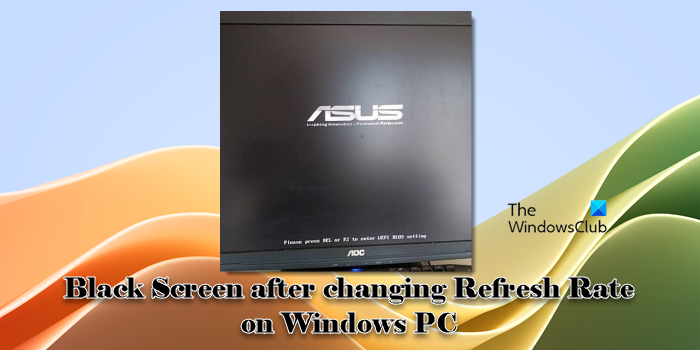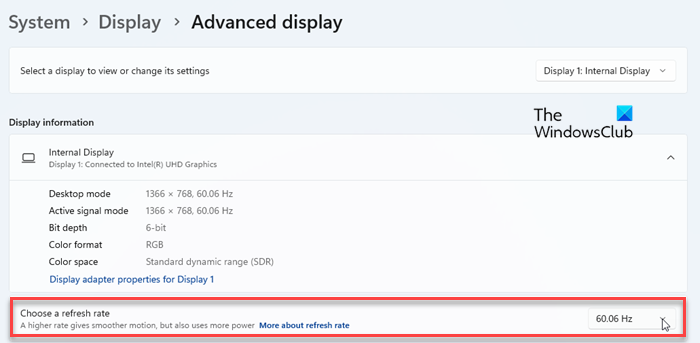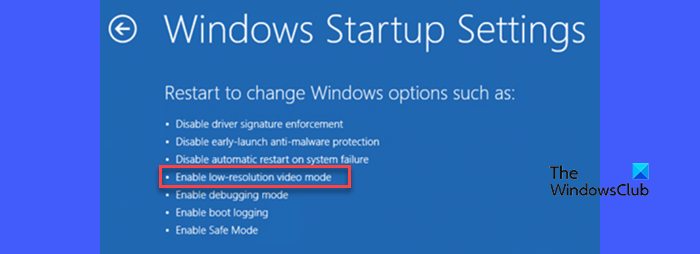If you see a Black Screen after changing the Refresh Rate on your Windows 11/10 PC, then this post will help you. We will show some effective troubleshooting steps to help you fix the issue. The default Refresh Rate for desktop monitors is 60Hz. You may change it to a higher value to get improved gaming or app performance, but going beyond the limit that your monitor supports may result in display glitches or a complete screen blackout.

Windows itself doesn’t allow setting the refresh rate to something your monitor doesn’t support, but third-party apps can. If your system’s graphics have been tweaked using such an app, you may face a situation where the system boots up, but instead of entering the usual desktop environment, the screen remains black. In this post, we will show you what to do if you accidentally change your display refresh rate to something your monitor can’t handle.
Why is my screen black on 144Hz?
The most common reason for black screen issues after changing the monitor refresh rate is choosing a rate outside a monitor’s refresh rate capabilities. Apart from this, hardware incompatibility, graphics driver issues, third-party software conflicts, and incorrect display settings can also lead to a black screen on a Windows 11/10 PC. Before making any adjustments to the refresh rate, it is always better to check that your graphics card and your monitor, both support the desired refresh rate.
Fix Black Screen after changing Refresh Rate on Windows PC
To fix the black screen issue after changing the refresh rate on your Windows 11/10 PC, follow these solutions:
- Reset graphics drivers
- Enable low-resolution video mode
Let us see this in detail.
1] Reset graphics drivers

Press the Win+Ctrl+Shift+B keys together and see if you can recover from the black screen. This key combination refreshes or resets the graphics drivers, addressing situations where there might be a display issue due to a graphics driver problem, such as a black screen.
Your screen may flicker a bit but should potentially fix the black screen issue. Once you’re out of the black screen, right-click on the desktop and select Display settings. Click on Advanced display under Related settings and change the refresh rate back to the previous setting.
Read: Black screen after installing Graphics driver
2] Enable low-resolution video mode

If the above solution doesn’t work, you must boot your system into Safe Mode and turn on the ‘Enable low-resolution video’ feature to fix the black screen issue. This feature allows you to start your computer with a lower screen resolution. This can be useful if you’re experiencing a black screen and need a way to access your system to make adjustments.
Press and hold the Shift key while clicking the Restart button on your computer to boot your system into Safe mode. You’ll see a ‘Choose an option‘ screen. Click on Troubleshoot > Advanced Options > Startup Settings. Click on the Restart button.
Followed by a quick restart, you will see a list of options on the Startup Settings screen. Press the F3 key or 3 key. Your system will restart into low-resolution video mode.
Fix: Black Screen after shutdown on Windows computer
Once you get the display back, revert to the previous refresh rate, as explained above. Then switch to your default resolution settings. Right-click on your desktop and select Display Settings. Navigate to System > Display. Select the recommended display in the Display resolution dropdown.
I hope this will help fix the black screen issue on your system.
Read: The bottom half of the screen is black on my laptop
How to fix a black screen after adjusting display settings in Windows?
Try fixing corrupt or incorrect drivers. Hold the Shift key while clicking on the Restart button to access the Advanced Startup Options. Go to Troubleshoot > Advanced Options and select Enable Safe Mode under Startup Settings. When your PC restarts in Safe Mode, right-click on the Start button icon and select Device Manager. Expand the Display adapters section and right-click on the graphics driver. Select Uninstall device. Your system will delete the driver and reinstall it on the next reboot.
Read Next: Refresh Rate changes automatically when unplugging the Charger.
Leave a Reply